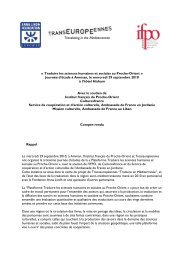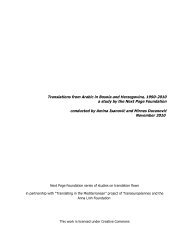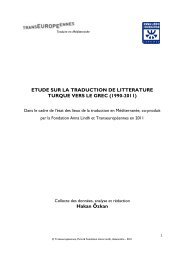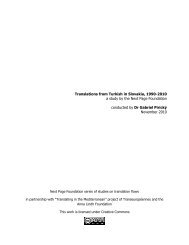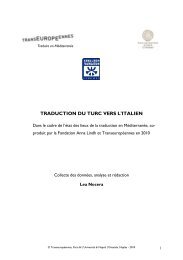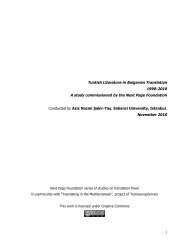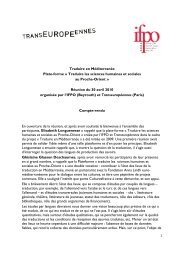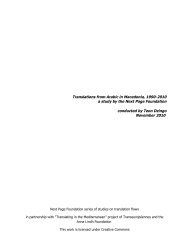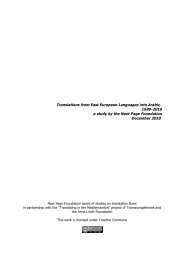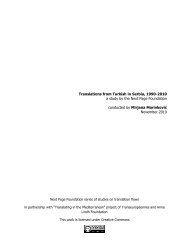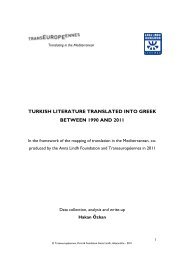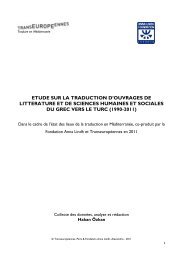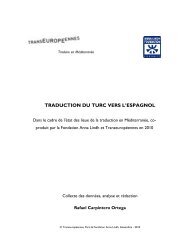Read the Arabic-Finnish study - Maria PAKKALA - Transeuropéennes
Read the Arabic-Finnish study - Maria PAKKALA - Transeuropéennes
Read the Arabic-Finnish study - Maria PAKKALA - Transeuropéennes
You also want an ePaper? Increase the reach of your titles
YUMPU automatically turns print PDFs into web optimized ePapers that Google loves.
Translating in <strong>the</strong> MediterraneanTRANSLATING FROM ARABIC INTO FINNISHData collection, analysis and write up<strong>Maria</strong> Pakkala© Transeuropéennes, Paris & Anna Lindh Foundation, Alexandria - 2011
PreambleThe following <strong>study</strong> is conducted by Transeuropéennes in partnership with <strong>the</strong> AnnaLindh Foundation (Translating in <strong>the</strong> Mediterranean). It is a component of <strong>the</strong> first mappingof translation in <strong>the</strong> Mediterranean, led since 2010 by Transeuropéennes and <strong>the</strong> AnnaLindh Foundation (Euro-Mediterranean program for translation), in partnership with overfifteen organizations from all over <strong>the</strong> Union for <strong>the</strong> Mediterranean.Sharing a common and wider vision of translation, of <strong>the</strong> central role that it must play inEuro-Mediterranean relationships, in <strong>the</strong> enrichment of languages, in <strong>the</strong> development ofsocieties, in <strong>the</strong> production and circulation of knowledge and imaginaries, <strong>the</strong> partnersga<strong>the</strong>red around this project shall use this inventory as a basis to formulate and take longterm actions.INTRODUCTIONThis <strong>study</strong> is carried out by Transeuropéennes in cooperation with <strong>the</strong> Anna Lindh Foundationand o<strong>the</strong>r organizations. It is part of <strong>the</strong> project of mapping <strong>the</strong> translation in <strong>the</strong>Mediterranean, conducted since 2010 by Transeuropéennes and <strong>the</strong> Anna Lindh Foundation(Euro-Mediterranean programme for translation), in partnership with over fifteenorganizations from <strong>the</strong> entire Union for <strong>the</strong> Mediterranean.Sharing a common and wider vision of translation, of <strong>the</strong> central role that it must play inEuro-Mediterranean relationships, in <strong>the</strong> enrichment of languages, in <strong>the</strong> development ofsocieties, in <strong>the</strong> production and circulation of knowledge and imaginaries, <strong>the</strong> partnersga<strong>the</strong>red around this project shall use this inventory as a basis to formulate and take longterm actions.METHODOLOGICAL NOTEThis <strong>study</strong> aims at analyzing <strong>the</strong> translation flow from <strong>Arabic</strong> into <strong>Finnish</strong> in <strong>the</strong> last 25 years,with a special attention to <strong>the</strong> last 15 years. The information on <strong>the</strong> flow of translation wascollected through research at <strong>the</strong> national Bibliography of Finland 1 , <strong>the</strong> library database of <strong>the</strong>University of Helsinki 2 , <strong>the</strong> databases of <strong>Finnish</strong> city libraries 3 , FILI‘s translation database 4 ,1 https://fennica.linneanet.fi last visited 11.11.20112 http://www.helka.fi last visited 11.11.20113 www.helmet.fi, www.jkl.fi/kirjasto, www.turku.fi/kirjasto, etc. last visited 11.11.2011© Transeuropéennes, Paris & Anna Lindh Foundation, Alexandria - 2011
and through interviewing a number of translators and editors. Ano<strong>the</strong>r valuable source was<strong>the</strong> essays and articles published by <strong>Finnish</strong> Arabists and Orientalists on <strong>the</strong> history of<strong>Arabic</strong> and Middle Eastern studies in Finland 5 . Fur<strong>the</strong>rmore, <strong>the</strong> cooperation projects of <strong>the</strong><strong>Finnish</strong> Foreign ministry and <strong>the</strong> newspaper articles on <strong>the</strong> subject helped ga<strong>the</strong>r fur<strong>the</strong>ruseful information. Hence, this <strong>study</strong> covers <strong>the</strong> publications and activities related to <strong>Finnish</strong><strong>Arabic</strong> translation up till September 2011.This <strong>study</strong> is carried out according to <strong>the</strong> guidelines provided by TEM. In <strong>the</strong> initial part ofthis research, I collected all <strong>the</strong> translations published in Finland and abroad, <strong>the</strong> amount ofwhich, however, did not exceed 53 entries. The graphs and charts provided here are meantto make <strong>the</strong> information clearer especially that no data about translating <strong>Arabic</strong> literaturecould be found from <strong>the</strong> <strong>Finnish</strong> Center of Statistics 6 nei<strong>the</strong>r from <strong>the</strong> <strong>Finnish</strong> book publishersassociation or any o<strong>the</strong>r authority 7 . The data provided by <strong>the</strong> UNESCO‘s Index Translationumdatabase for example is incomplete and contains some mistakes. The data provided by <strong>the</strong><strong>Finnish</strong> Literature Exchange is not complete ei<strong>the</strong>r.HISTORICAL SUMMARYIn his ‗Arab Studies in Finland since <strong>the</strong> Seventeenth Century 8 ‘, <strong>the</strong> professor emeritus of <strong>Arabic</strong>studies, Dr. Heikki Palva gives <strong>the</strong> impression that <strong>the</strong> tradition of <strong>Arabic</strong> studies in Finland islong but quite thin. The interest in <strong>the</strong> <strong>Arabic</strong> language and <strong>the</strong> Arab countries in Finlandgoes back to <strong>the</strong> eighteenth century. The main reason that drew <strong>the</strong> attention of Finns to<strong>the</strong> linguistically and culturally remote Arabia was mainly <strong>the</strong>ological. For <strong>Finnish</strong><strong>the</strong>ologians, <strong>the</strong> <strong>Arabic</strong> language and <strong>the</strong> Bedouin lifestyle in <strong>the</strong> Middle-East was a means forreaching a better understanding of <strong>the</strong> ancient Israelites‘ environment and life style. Studying<strong>Arabic</strong> would help understand <strong>the</strong> Hebrew Bible and <strong>study</strong>ing <strong>the</strong> Arab lifestyle would makeit easier to better understand <strong>the</strong> Biblical lifestyle.All started with two Finns: Peter Forsskål (1732-1763) and Wilhelm Ross (1718-1766).Forsskål studied <strong>Arabic</strong> at <strong>the</strong> University of Uppsala, and was offered an opportunity to4 http://dbgw.finlit.fi/kaannokset last visited 11.11.20115 Jaakko Hämeen-Anttila, Middle Eastern Studies in Finland, Middle East Studies AssociationBulletin, June 2004, p.41-436 www.stat.fi last visited 11.11.20117 www.kustantajat.fi last visited 11.11.20118 Palva, Heikki (2001), ‘Arab Studies in Finland since <strong>the</strong> Seventeenth Century’, Proceedings of <strong>the</strong><strong>Finnish</strong> Institute in <strong>the</strong> Middle East 1. Vantaa: The <strong>Finnish</strong> Institute in <strong>the</strong> Middle East.© Transeuropéennes, Paris & Anna Lindh Foundation, Alexandria - 2011
participate in an expedition to ‗Arabia Felix‘ financed by <strong>the</strong> Danish king Frederik V in 1761.Forsskål joined <strong>the</strong> expedition as a biologist who turned out to be <strong>the</strong> most importantArabist. He died of malaria in Yemen. Forsskål’s trip was widely discussed. Hence, WilhelmRoss, <strong>the</strong>n associate professor of oriental languages, got <strong>the</strong> idea of starting a pilgrimage tripto <strong>the</strong> Promised Land. Indeed, he left in April 1763 for Jerusalem but never reached hisdestination as he died in <strong>the</strong> desert near Damascus in <strong>the</strong> summer of 1766.G.A. Wallin (d. 1852) is probably <strong>the</strong> best known <strong>Finnish</strong> Orientalist and Arabist. He travelledin <strong>the</strong> Arabian Peninsula and in a number of Arab countries in <strong>the</strong> eighteenth century. Hekept a diary and wrote about <strong>the</strong> lifestyle and <strong>the</strong> language of <strong>the</strong> people of <strong>the</strong> area. Hisdiaries continue to be read nowadays in Finland and elsewhere. His importance is seen,among o<strong>the</strong>rs, from <strong>the</strong> number of books published in Finland and abroad about him and hisexperiences in <strong>the</strong> Arab world. He is <strong>the</strong> first Orientalist explorer to come back alive fromArabia.For a bibliographical reference of studies on <strong>Arabic</strong> culture and language, see ―Arab Studies inFinland since <strong>the</strong> Seventeenth Century‖ 9 and <strong>the</strong> bibliographical note at <strong>the</strong> end of this report.The <strong>Finnish</strong> scholarship in Middle Eastern studies remains practically only at <strong>the</strong> departmentof World Cultures at <strong>the</strong> University Helsinki 10 . On <strong>the</strong> o<strong>the</strong>r hand, I dare say that <strong>the</strong><strong>Finnish</strong> scholarship concentrates more on <strong>the</strong> <strong>the</strong>ological and <strong>the</strong> philosophical aspects thanon <strong>the</strong> linguistic ones.LANGUAGE COURSES<strong>Arabic</strong> is taught mainly at <strong>the</strong> University of Helsinki. The department of World Cultures 11 hasoffered BA and MA programs in <strong>Arabic</strong> since 1980, <strong>the</strong> year <strong>the</strong> chair of <strong>Arabic</strong> wasestablished. Before that, <strong>Arabic</strong> was taught at <strong>the</strong> department of Semitic studies. ProfessorHeikki Palva held <strong>the</strong> chair of <strong>Arabic</strong> studies from 1982 to 1998. After him, <strong>the</strong> chair‘s namewas changed into <strong>Arabic</strong> and Islamic studies, and is held by Professor Jaakko Hämeen-Anttilasince 2000.9 Heikki Palva, Arab Studies in Finland since Seventeenth Century. Ed. Aarne Toivanen. Proceedingsof <strong>the</strong> <strong>Finnish</strong> Institute in <strong>the</strong> Middle East 1/2001.10 Jaakko Hämeen-Anttila, Middle Eastern Studies in Finland, Middle East Studies AssociationBulletin, June 2004, p.41-43.11 Until 2010, <strong>the</strong> department’s name was ‘The institute of Asian And African Studies’.© Transeuropéennes, Paris & Anna Lindh Foundation, Alexandria - 2011
Despite <strong>the</strong> increasing interest in <strong>Arabic</strong> and Islam after <strong>the</strong> 11/9, <strong>the</strong>re was no significantincrease in <strong>the</strong> interest in <strong>the</strong> academic programs offered by <strong>the</strong> department of <strong>Arabic</strong> andIslamic studies. However, <strong>the</strong>re is a clear increase in <strong>the</strong> interest in <strong>Arabic</strong> language courses.Even if <strong>the</strong> department of <strong>Arabic</strong> and Islamic studies offers some classes in translation(<strong>Arabic</strong>-<strong>Finnish</strong> translation, 5 ECTS-credits and <strong>Finnish</strong>-<strong>Arabic</strong> translation, 5 ECTS-credits),<strong>the</strong>re are no <strong>Arabic</strong> translation degree programs in Finland. However, <strong>the</strong> departmentstarted an opportunity to <strong>study</strong> <strong>Finnish</strong> for translators in 2010. The module is 25 ECTScreditsin <strong>the</strong> <strong>Finnish</strong> language. The courses in this module are syntax, and morphology. Thestudents interviewed for this research stated that <strong>the</strong> future translators would benefit morefrom a module in <strong>the</strong> <strong>Arabic</strong> language.Today, <strong>the</strong>re are a number of universities and schools offering introductory courses of<strong>Arabic</strong>. However, advanced level courses are not offered anywhere.To fill this gap, <strong>the</strong> University of Helsinki started a program incooperation with <strong>the</strong> <strong>Finnish</strong> Institute in Damascus 12 and <strong>the</strong> HelsinkiSummer University. This cooperation allows students to participate inan intensive course of Syrian <strong>Arabic</strong>, part of which is held inDamascus. This 5 ECTs course, as necessary as it is, is unfortunatelynot sufficient to fill <strong>the</strong> huge gap in <strong>Arabic</strong> language education. Theproblem of diglossia makes <strong>the</strong> situation even worse for students of<strong>Arabic</strong> because, in addition to Modern Standard <strong>Arabic</strong>, <strong>the</strong>y need tolearn at least one spoken version of <strong>Arabic</strong> to get a taste of <strong>the</strong> Arab culture.MAJOR TRENDS OF TRANSLATION IN FINLANDThere are no books or anthologies entirely devoted to authors from <strong>Arabic</strong> speakingcountries in Finland. However, Naguib Mahfouz and Tahar ben Jelloun are mentioned in abook named ‗Foreign contemporary writers 2‘. 13Some stories of <strong>the</strong> classic ‗One Thousand and One Night‘ found its way to <strong>the</strong> <strong>Finnish</strong> readeralready in <strong>the</strong> eightieth century. The first to translate <strong>the</strong>se stories was F. Hoffmann(Söderström 1874 - 1877). However, <strong>the</strong> most famous edition was <strong>the</strong> one published by12 www.damascus.fi13 Ulkomaisia nykykertojia. 2 edit. Ritva Aarnio & Ismo Loivamaa, Helsinki: BTJ Kirjastopalvelu, 1998© Transeuropéennes, Paris & Anna Lindh Foundation, Alexandria - 2011
WSOY (1956-1957) 14 . Since <strong>the</strong>n, more and more editions were issued both for childrenand for adults. All <strong>the</strong>se translations were made via many bridge languages. The first directtranslations are made in 2001 15 and 2010 by Professor Hämeen-Anttila.I did not include <strong>the</strong> different translations of this classic in my statistics for two reasons. Thefirst one is <strong>the</strong> lack of information about <strong>the</strong> source text in most of <strong>the</strong>se cases. The secondreason is a statistical one. Had I included all <strong>the</strong> translations and editions of <strong>the</strong> ‗OneThousand and One Night‘, a wrong idea would be conveyed on <strong>the</strong> general flow oftranslation from <strong>Arabic</strong> in Finland. If <strong>the</strong> overall number of titles translated is 53, adding 33different editions of <strong>the</strong> ‗One Thousand and One Night‘ would be adding 62.26% of <strong>the</strong> data.Ano<strong>the</strong>r success story in <strong>the</strong> <strong>Finnish</strong> market is Khalil Gibran. Many of Khalil Gibran‘s bookswere translated into <strong>Finnish</strong>, mostly via English though. ‗The Prophet‘ for example has beenpublished by three different editors. One of <strong>the</strong>m issued nineteen editions of this book.The Qur‘ān was translated by two academics. The late Professor Jussi Aro translated <strong>the</strong>Qur‘ān into <strong>Finnish</strong> in 1957. Five reprints were taken of his translation, <strong>the</strong> latest of which isin 2006. Professor of <strong>Arabic</strong> and Islamic studies Jaakko Hämeen-Anttila also translated <strong>the</strong>Qur‘ān in 1995. A second edition was published in 1997.HISTORIC VIEW OF TRANSLATION FROM ARABIC INTO FINNISHAs <strong>the</strong> chart below shows, a good number of translations from <strong>Arabic</strong> saw <strong>the</strong> light in <strong>the</strong>eighties and <strong>the</strong> nineties even if some of <strong>the</strong>m were made through English. In 1988, <strong>the</strong>Egyptian writer Naguib Mahfouz was awarded <strong>the</strong> Nobel Prize. One year later, translationsof his works started to appear in <strong>Finnish</strong>. This might have been <strong>the</strong> reason behind <strong>the</strong> startof interest in <strong>Arabic</strong> literature.14 Tuhat ja yksi yötä, Jaakko Hämeen-Anttila, Otava, 2010, p.6.15 Kuka murhasi kyttyräselän? Tarinoita Tuhannesta ja yhdestä yöstä. translated by Hämeen-AnttilaJaakko, Basam Books, 2001.© Transeuropéennes, Paris & Anna Lindh Foundation, Alexandria - 2011
Flow of Translations from <strong>Arabic</strong> into <strong>Finnish</strong>1816141210864201920 1950 1960 1970 1980 1990 2000 2010 20111. DIRECT AND INDIRECT TRANSLATIONS 1925-2011The following chart shows <strong>the</strong> flow of translation of <strong>Arabic</strong> literature in Finland in <strong>the</strong> last25 years:43 3 33332 22221 1 11 11 1 11 1© Transeuropéennes, Paris & Anna Lindh Foundation, Alexandria - 2011
THE TRANSLATED GENRES IN FINLANDThe chart below shows <strong>the</strong> 42 books translated from <strong>Arabic</strong> into <strong>Finnish</strong> in <strong>the</strong> last 25 years.Literature plays a leading role, with about 68% of <strong>the</strong> total. O<strong>the</strong>r translations are devoted to Islam,Poetry and Children‘s literature.Categories of translation from <strong>Arabic</strong> into<strong>Finnish</strong>Poetry7%Children'sO<strong>the</strong>r literatureTheatre6% 0% 4%2%Islam13%Fiction68%The most translated Arab authors are Khalil Gibran with six titles, Naguib Mahfouz with five titles,and Nawal El Saadawi with four titles. The fame of Gibran made him extremely popular in Finland.Mahfouz was translated into <strong>Finnish</strong> only after he won <strong>the</strong> Nobel Prize in 1988. El Saadawi waspublished by Kääntöpiiri, an editor promoting Feminist literature.76543210Khalil Gibran Naguib Mahfouz Nawal ElSaadawiThe most translatedauthors© Transeuropéennes, Paris & Anna Lindh Foundation, Alexandria - 2011
BILINGUAL WORKSThere is only one bilingual title published in Finland. The title is edited by Faruk Abu Chakra.Souad Al-Sabah‘s ‗Alussa oli nainen‘ translated by Sari Kuustola. Abu Chakra opted for abilingual title because he wished <strong>the</strong> reader to see <strong>the</strong> original text as well—even if <strong>the</strong>reader would not know <strong>Arabic</strong> 16 . No o<strong>the</strong>r bilingual titles exist in <strong>the</strong> <strong>Finnish</strong> market.Publishers who do not offer bilingual editions impute <strong>the</strong>ir choice to <strong>the</strong> technical difficultieswith <strong>Arabic</strong> fonts.Direct vs. Indirect translation into <strong>Finnish</strong>Indirect31%Direct69%Professor Jussi Aro (d. 1983), an Assyriologist who kept alive <strong>Arabic</strong> philological studies at<strong>the</strong> University of Helsinki, translated a number of books directly from <strong>Arabic</strong> into <strong>Finnish</strong>.Professor Heikki Palva, who held <strong>the</strong> chair of <strong>Arabic</strong> studies from 1982 to 1998, alsotranslated a book from <strong>Arabic</strong> into <strong>Finnish</strong> and edited a number of books on <strong>the</strong> <strong>Arabic</strong> andIslamic culture.Dr. Marko Juntunen, an anthropologist who spent many years in Morocco <strong>study</strong>ingimmigration, has compiled and translated a number of important books. It is thanks to Dr.Juntunen that <strong>the</strong> <strong>Finnish</strong> reader was introduced to <strong>the</strong> Moroccan writer Mohammad16 Faruk Abu Chakra, An interview by <strong>Maria</strong> Pakkala in 30.8.2011.© Transeuropéennes, Paris & Anna Lindh Foundation, Alexandria - 2011
Choukri‘s ‗Plain Bread’ and ‗The Time of Mistakes‘. Dr. Juntunen also translated a number ofmanuscripts for two Iraqi writers who reside in Finland.Until now, one of <strong>the</strong>se Iraqi writers, Jusif Abu Al Fawz, is exclusively translated into <strong>Finnish</strong>.The collection of short stories of <strong>the</strong> second Iraqi writer Hassan Blasim finally found its wayto <strong>the</strong> <strong>Finnish</strong> editor OTAVA. This collection of short stories was never published in <strong>Arabic</strong>but was translated into English by Jonathan Wright as ―The Madman of Freedom Square‖ 17 .Mr. Sampsa Peltonen, an excellent translator, AV translator, and interpreter, translated AlaAl-Aswani‘s ‗Chicago’ and ‗Yaacobian building 18 ‘ in addition to Rajaa al-Sanea‘s ‗The girls of Riyad‘.All of Mr. Peltonen‘s translations are a real success. In addition to <strong>the</strong> fact that <strong>the</strong>se titlesare best sellers elsewhere, Mr. Peltonen‘s smooth style and deep knowledge of <strong>the</strong> Arabculture make his translations vivid and believable. The writers of <strong>the</strong>se books have nevervisited Finland or appeared on <strong>the</strong> <strong>Finnish</strong> TV. However, <strong>the</strong> critics have welcomed <strong>the</strong>setranslations and applauded <strong>the</strong>m warmly 19 . Moreover, <strong>the</strong> books sold well and <strong>the</strong> lendingqueues at <strong>the</strong> public libraries were long.However, <strong>the</strong> most prolific translator who translates directly from <strong>Arabic</strong> into <strong>Finnish</strong> isProfessor Jaakko Hämeen-Anttila. He has a major role in drawing <strong>the</strong> attention of a largereadership to books related to <strong>Arabic</strong> and Islamic literature. He was awarded a number ofprizes for his tremendous efforts in popularizing science, translating Middle Easter literature,and compiling tens of books on <strong>the</strong> Middle East. Professor Hämeen-Anttila is an importantpublic figure in <strong>the</strong> country and a highly respected authority.All <strong>the</strong> translators in Finland, who translate directly from <strong>Arabic</strong>, are native <strong>Finnish</strong> speakers.The only exception is Mr. Sahban Mroueh, who is a Lebanese writer and a poet. Hetranslated both from and into <strong>Finnish</strong> and has written and translated a large number of playsand documentaries for <strong>the</strong> <strong>Finnish</strong> TV.Some translators have quit <strong>Arabic</strong> translations. Mr. Pekka Suni, an important translator whotranslated five works of Naguib Mahfouz directly from <strong>Arabic</strong> into <strong>Finnish</strong>, has quit17 Hassan Blasim, Madman of Freedom Square, Comma Press, 2009, translated from <strong>Arabic</strong> byJonathan Wright. The writer told me that <strong>the</strong> <strong>Arabic</strong> book was never published because of censorshipproblems.18 A. al-Aswani,‘Imarat Yaqubian, Maktabat Madbuli, Cairo 2002; Yacoubian-talon tarinat, trans. bySampsa Peltonen, WSOY, Helsinki 2009.19 www.kepa.fi/kumppani/arkisto/2009_7-8/7199;www.hs.fi/kirjat/artikkeli/Kerrostalossa+asuu+koko+1900-luku/HS20090907SI1KU01tvi;www.kirjavinkit.fi/arvostelut/riadin-tytot; www.sivupiiri.fi/kirja-arvostelut/riadin-tyt%C3%B6t-368among o<strong>the</strong>rs© Transeuropéennes, Paris & Anna Lindh Foundation, Alexandria - 2011
translating from <strong>Arabic</strong> for economical reasons 20 . It is thanks to Mr. Suni that <strong>the</strong> <strong>Finnish</strong>reader was introduced to Mahfouz. He now translates mainly from English and makes aliving designing WebPages and translating industrial documents.THE MOST PROLIFIC TRANSLATORS WHO TRANSLATE DIRECTLY ANDINDIRECTLY FROM ARABIC INTO FINNISHThe most prolific translatorsSampsa Peltonen6%Sahban Mroueh4%Pekka Suni9%Sari Kuustola4%JaakkoHämeen-Anttila21%Jussi Aro5%O<strong>the</strong>rs36%Kaarina Turja et al9%Marko Juntunen6%20 A phone conversation with Mr. Pekka Suni 25.9.2011.© Transeuropéennes, Paris & Anna Lindh Foundation, Alexandria - 2011
THE MOST PROLIFIC TRANSLATORS WHO TRANSLATE DIRECTLY FROMARABIC INTO FINNISHThe most prolific translators who translatedirectly from <strong>Arabic</strong>Sahban Mroueh7%Sari Kuustola7%Sampsa Peltonen10%Marko Juntunen10%Jussi Aro11%Pekka Suni17%Jaakko Hämeen-Anttila38%PUBLISHERS TRANSLATING ARABICThe major <strong>Finnish</strong> publishers (WSOY, OTAVA and Tammi) have published toge<strong>the</strong>r only22% of <strong>the</strong> titles translated from <strong>Arabic</strong> into <strong>Finnish</strong>. Two small publishers lead <strong>the</strong> marketby publishing 13% (Basam Books) and 11% (Karisto) of <strong>the</strong> books translated from <strong>Arabic</strong>.Basam Books Ltd 21 is a Helsinki-based publisher. Its specialties are <strong>the</strong> oriental literature,poetry, philosophy, literary classics, religion, wisdom literature, and spiritual growth. Thispublisher started in 1993 and annually publishes about 30-40 books. The company's founderand director is Batu Samaletdin, who previously held a used-book store 22 . Basam BooksClassic Series present <strong>the</strong> best known literary works from <strong>the</strong> oriental world.The translations from <strong>Arabic</strong> published by Basam Books are made mainly in cooperationwith Professor Jaakko Hämeen-Anttila who translates mainly classical works. He, however,translated two modern writers: Adonis and Hanan El-Cheikh.21 www.basambooks.com22 http://www.helsinki.fi/jarj/katharsis/teema/teema302/basam.htm© Transeuropéennes, Paris & Anna Lindh Foundation, Alexandria - 2011
Mr. Faruk Abu-Chacra has used his own contacts and abilities to publish translations. Selfpublishingcan be an option for some. However, <strong>the</strong> translators interviewed for this <strong>study</strong>would not opt for such a solution because of <strong>the</strong> load of work and responsibility involved init.Mr. Faruk Abu-Chacra helped translating al-Babtain‘s selection of poems into <strong>Finnish</strong>. He <strong>the</strong>npublished <strong>the</strong> book in Kuwait. Although a very famous person promoting <strong>Arabic</strong> culture andliterature, al-Babtain‘s poems would have never reached <strong>the</strong> <strong>Finnish</strong> market because of itsaverage quality. It is only because of Mr. Faruk Abu-Chacra’s personal contact that this projectsaw <strong>the</strong> light.Usually, <strong>the</strong> <strong>Finnish</strong> publishers only publish very successful poets and authors or trust <strong>the</strong>judgment of a small number of experts. The chart below shows <strong>the</strong> <strong>Finnish</strong> publishers whopublish <strong>Arabic</strong> books:Publishers translating <strong>Arabic</strong>O<strong>the</strong>rs32%Basam books13%Kääntöpiire10%Karisto11%WSOY9%Tammi9%Otava4%Kirjapaja4%LIKE-Publishers8%© Transeuropéennes, Paris & Anna Lindh Foundation, Alexandria - 2011
NUMBER OF TITLES PUBLISHED YEARLY (1925-2011)YEAR PUBLICATIONS YEAR PUBLICATIONS YEAR PUBLICATIONS1925 1 1988 1 2001 21950 1 1989 3 2003 11957 1 1990 3 2004 11974 1 1992 3 2005 11978 2 1993 2 2006 21979 1 1995 2 2007 41982 1 1996 3 2008 31983 1 1997 1 2009 11986 1 1998 1 2010 11987 1 1999 3 2011 2There was only a slight change in <strong>the</strong> number of translations from <strong>Arabic</strong> published yearly inFinland as <strong>the</strong> chart above shows 23 . Note that yearly publication started only from 2003onwards.PERCENTAGE OF ARABIC TRANSLATION COMPARED TO OTHER LANGUAGESThe center of statistics contacted during <strong>the</strong> collection of data for <strong>the</strong> present research saysthat no statistics are available. Hence, it is difficult to give a precise percentage.STATUS OF TRANSLATORSAll <strong>the</strong> translators related to this <strong>study</strong> have more than one profession. Those who translatefor a living translate from several languages or translate also different documents. Until <strong>the</strong>nineties, most translations were made via a bridge language. Most of <strong>the</strong> direct translationsfrom <strong>Arabic</strong> into <strong>Finnish</strong> are made by academic people 24 for whom <strong>the</strong> translation is more ofa passion than a source of economical income. However, this poorly paid profession makesit difficult for professional translators not to give it up. Many translators interviewed for this23 Both direct and indirect translations are included in this chart.24 Prof. Jussi Aro, Prof. Jaakko Hämeen-Anttila, and Marko Juntunen.© Transeuropéennes, Paris & Anna Lindh Foundation, Alexandria - 2011
esearch agreed that <strong>the</strong>y gave up translation work completely or refused some titlesbecause of economical reasons.However, translators are respected in Finland and are encouraged almost <strong>the</strong> same way asresearchers. This is seen through <strong>the</strong> different seminars, events and grants designed to help<strong>the</strong> translators carry out <strong>the</strong>ir work.In Finland, <strong>the</strong> translator‘s name is usually written inside <strong>the</strong> book—not on its cover. Someof Professor Hämeen-Anttila‘s translations are an exception to this practice.REMUNERATION OF TRANSLATIONThe remuneration of translators in Finland varies depending on <strong>the</strong> work, <strong>the</strong> reputation of<strong>the</strong> translator, and <strong>the</strong> publisher‘s financial means. The translators interviewed for thisresearch spoke of wages ranging between 0.5 to 20 Euros a page. Some of <strong>the</strong>m havesucceeded in obtaining translation grants from associations or organizations supportingculture—o<strong>the</strong>rs were less lucky.GRANTSThe <strong>Finnish</strong> Literature Exchange — FILIThe most important source of financial, educational and cultural support for translators is<strong>the</strong> <strong>Finnish</strong> Literature Exchange—FILI. FILI promotes interest in <strong>Finnish</strong> literature abroad bysupporting its translation and publication. FILI was founded in 1977 and is part of <strong>the</strong> <strong>Finnish</strong>Literature Society, which has operated since 1831. FILI awards annually translation andpublication grants; organizes a translator-in-residence programme at Suomenlinna(Sveaborg) in Helsinki; organizes translator seminars; runs an internship scheme for youngtranslators; offers a virtual community for translators of <strong>Finnish</strong> literature; provides literaryinstitutions, festivals, universities and publishers subsidies towards <strong>the</strong> travel costs ofauthors taking part in literary programmes or promotional activities in connection withtranslated works; cooperates with foreign publishers, book fairs and literary institutes inorganizing occasional major literary events abroad presenting <strong>Finnish</strong> authors and <strong>the</strong>ir© Transeuropéennes, Paris & Anna Lindh Foundation, Alexandria - 2011
work; invites foreign publishers to Finland to introduce <strong>the</strong>m to <strong>the</strong> literary scene; maintainsa unique database of translations of <strong>Finnish</strong> literature; publishes <strong>the</strong> online literary journalBooks from Finland, which was established since 1967 and has been online since 2009 .FILI awards translators travel grants to cover <strong>the</strong> costs of work or <strong>study</strong> trips. As far asforeign publishers are concerned, FILI awards <strong>the</strong>m grants for translation and printing. Theymay apply for a grant for <strong>the</strong> translation of <strong>Finnish</strong>, Finland-Swedish and Sámi literature intoo<strong>the</strong>r languages. Funding is awarded primarily for <strong>the</strong> translation of <strong>Finnish</strong> literature, thougha number of grants are awarded for <strong>the</strong> translation of works of non-fiction dealing withaspects of <strong>Finnish</strong> culture.Publishers may apply for grants to cover translation expenses for works which have beenpublished in Finland and translated directly from <strong>Finnish</strong>, Swedish or Sámi into o<strong>the</strong>rlanguages. Translation grants are not applicable to scientific or academic publications,dissertations, textbooks or dictionaries. The grants are awarded with <strong>the</strong> stipulation that<strong>the</strong> translator has professional experience and is a native of <strong>the</strong> target language.The annual deadlines for grant applications are 1st April and 1st November each year. Theapplication must be accompanied by a copy of <strong>the</strong> signed contract between <strong>the</strong> foreignpublisher and <strong>the</strong> <strong>Finnish</strong> copyright holder and a copy of <strong>the</strong> signed contract between <strong>the</strong>foreign publisher and <strong>the</strong> translator.Translation grants are paid when <strong>the</strong> publisher has delivered five copies of <strong>the</strong> finishedpublication to FILI. Fur<strong>the</strong>rmore, <strong>the</strong> translated book must include mention of <strong>the</strong> grantawarded by FILI.FILI offers <strong>the</strong> translators grants for translations, sample translations, and travelling to <strong>the</strong>countries where <strong>the</strong> translator‘s main language is spoken. It also organizes different seminarsand helps forming and maintaining contacts with editors. FILI also organizes, toge<strong>the</strong>r with<strong>the</strong> ministry of Culture, <strong>the</strong> state prize of translation awarded every year to a translationfrom <strong>Finnish</strong> into one of <strong>the</strong> world‘s languages.FILI offers five different forms of funding. Foreign publishers may apply for funding for <strong>the</strong>translation of <strong>Finnish</strong> literature into o<strong>the</strong>r languages. <strong>Finnish</strong> publishers are awarded fundingfor <strong>the</strong> translation into <strong>Finnish</strong> and Swedish. In addition to this, foreign publishers may applyfor funding to help with <strong>the</strong> costs of printing <strong>Finnish</strong> comics and children‘s picture books intranslation. Moreover, foreign translators may apply to FILI for sample translation grants.© Transeuropéennes, Paris & Anna Lindh Foundation, Alexandria - 2011
Sample translation grants are also awarded to foreign and <strong>Finnish</strong> publishers 25 . Translators of<strong>Finnish</strong> literature may also apply for travel grants to cover <strong>the</strong> costs of a work or <strong>study</strong> trip.The <strong>Finnish</strong> Institute in DamascusThe <strong>Finnish</strong> Institute in Damascus gives grants for students to <strong>study</strong> <strong>Arabic</strong> in addition togrants for translators and researchers to carry out translations or to travel to <strong>the</strong> MiddleEast. These grants are awarded yearly but <strong>the</strong>y are usually quite modest.There are o<strong>the</strong>r sources of financial support for translators in Finland such as <strong>the</strong> KONEfoundation 26 , Wihuri foundation 27 , <strong>the</strong> <strong>Finnish</strong> Cultural foundation 28 , Alfred Kordelin Foundation, and<strong>the</strong> <strong>Finnish</strong> Educational Fund 29 .Kone Foundation provides funding for <strong>Finnish</strong> non-fiction writing and translations from or into<strong>Finnish</strong>. Non-fiction grants are intended to support non-fiction writing and translation in <strong>the</strong>humanities, <strong>the</strong> social sciences and environmental research. The aim is to support efforts tomake research in <strong>the</strong>se fields as accessible as possible to <strong>the</strong> general public. The grants areawarded based on <strong>the</strong> importance of <strong>the</strong> titles chosen for translation. Kone Foundationprovides funding mainly for research. Hence, <strong>the</strong> number of translation grants per year isusually limited.Jenny and Antti Wihuri Foundation promotes cultural and economic development in Finland.The Foundation fulfills its purpose by distributing grants and awards and o<strong>the</strong>rwise by givingfinancial aid to activities, thus fur<strong>the</strong>ring <strong>the</strong> cultural and economic life of <strong>the</strong> country. LikeKone Foundation, Wihuri awards grants for translation works which <strong>the</strong> board regardsimportant or significant.The <strong>Finnish</strong> Cultural Foundation (SKR) awards grants to individuals, working groups andorganizations in <strong>the</strong> arts, science and various fields of cultural life through its Central Fundand 17 regional funds. Traditionally, SKR has awarded translation grants for importantliterary works.25 www.finlit.fi/fili/en/tuet/index.html last visited 11.11.201126www.koneensaatio.fi last visited 10.11.201127www.wihuri.fi last visited 10.11.201128www.skr.fi last visited 10.11.201129www.sivistysrahasto.com last visited 10.11.2011© Transeuropéennes, Paris & Anna Lindh Foundation, Alexandria - 2011
Alfred Kordelin Foundation primarily supports <strong>the</strong> translation of foreign language literatureinto <strong>Finnish</strong>, but also provides some financial assistance for <strong>the</strong> translation of <strong>Finnish</strong>literature into o<strong>the</strong>r languages.The board of <strong>the</strong> above mentioned foundations is formed of professors, scientists, artists,writers, and economics. Because <strong>the</strong>se foundation are established to serve more generalobjectives than <strong>the</strong> translation of <strong>Finnish</strong> literature, <strong>the</strong>y only award a few number oftranslation grants yearly.RESIDENCIESThe <strong>Finnish</strong> Institute in Damascus offers translators and researchers a residency opportunityin Damascus. The duration of <strong>the</strong> residency depends on <strong>the</strong> availability of rooms at <strong>the</strong>institute and on <strong>the</strong> duration applied for. Applicants send <strong>the</strong>ir applications to <strong>the</strong> instituteanytime of <strong>the</strong> year. It has been fairly easy to get this residency. It should be noted,however, that <strong>the</strong> institute has temporarily moved to Amman, Jordan because of <strong>the</strong> unrestin Syria 30 .In addition to <strong>the</strong> grants it offers, <strong>the</strong> KONE foundation 31 offers a residency program, whichallows researchers—but sometimes also translators to retreat and work in a beautifulmansion in Western Finland. Interested applicants can apply for a 2-month stay at <strong>the</strong>residence 32 .PRIZESAbout 50% of <strong>the</strong> books published in Finland are translations.Translation is a very important and respected activity. Likewise, <strong>the</strong>translators are appreciated as seen through <strong>the</strong> different translationprizes in <strong>the</strong> country:30 The institute moved to Amman, Jordan. The institute would probably resume <strong>the</strong> residencyprogram once <strong>the</strong> situation is settled down.31 www.koneensaatio.fi 11.11.201132 www.koneensaatio.fi/en/manor/presentation/ 11.11.2011© Transeuropéennes, Paris & Anna Lindh Foundation, Alexandria - 2011
Mikael Agricola PrizeThe prize, worth 5 050 Euros, has been awarded yearly since 1958 by <strong>the</strong> <strong>Finnish</strong>Association of Translators and Interpreters (SKTL). It is awarded simultaneously with <strong>the</strong> J.A.Hollo Prize. No translation from <strong>Arabic</strong> has been awarded this prize.J.A. HOLLO PrizeThe prize, worth 5 050 Euros, has been awarded yearly since 1991 by <strong>the</strong> <strong>Finnish</strong>Association of Translators and Interpreters (SKTL). It is awarded simultaneously with <strong>the</strong>Mikael Agricola Prize. No translation from <strong>Arabic</strong> has been awarded this prize.KÄÄNTÄJÄPALKINTO (The Translator Award)The prize, worth 2.000 to 5.000 Euros, is awarded by <strong>the</strong> Kalevi and Irene Sorsa Fund onceevery three years. No translation from <strong>Arabic</strong> has been awarded this prize.KÄÄNTÄJÄKARHU Prize of translationThe <strong>Finnish</strong> radio (Yleisradia) has awarded Kääntäjäkarhu-prize of translation for <strong>the</strong> bestliterary translation of <strong>the</strong> year. The prize, worth 1750 Euros, has been awarded almostyearly since 1994. No translation from <strong>Arabic</strong> has been awarded this prize.THE FINNISH ASSOCIATION OF TRANSLATORSThe <strong>Finnish</strong> Association of Translators and Interpreters–known in Finland as SKTL, anabbreviation derived from <strong>the</strong> Association‘s name in <strong>Finnish</strong>, is a professional organizationfounded in 1955. The Association‘s objectives include: to advance <strong>the</strong> professional interestsof translators and interpreters; to promote national and international co-operation within<strong>the</strong> sector; to foster <strong>the</strong> education and training of translators and interpreters, <strong>the</strong>rebycontributing to improved quality within <strong>the</strong> sector; and to promote compliance withinternational recommendations concerning translation and interpreting. 33The Association has some 1,800 members, grouped into five sections:• Literature translators33 www.sktl.fi 11.11.2011© Transeuropéennes, Paris & Anna Lindh Foundation, Alexandria - 2011
• Document translators• AV translators• Interpreters• Teachers and researchersThe association issues a monthly paper called Kääntäjä-översättaren. The publication has beenpublished without a break since 1970. It is currently released ten times a year, in issues eightor twelve pages long.The association awards four translation prizes. The first prize is designed to encourageliterary translation into <strong>Finnish</strong>; <strong>the</strong> second encourage non-fiction translations into <strong>Finnish</strong>;<strong>the</strong> third is related to interpretation and <strong>the</strong> fourth to <strong>the</strong> spirit of customer service.QUALITY AND CRITICAL RECEPTION OF TRANSLATIONThe translation quality in Finland is very high. However, <strong>the</strong>re are no verificationmechanisms available to measure quality. Usually editors send <strong>the</strong> translated texts to aspecialist in <strong>the</strong> subject of <strong>the</strong> book when possible. Some editors compare <strong>the</strong> translatedwork with ano<strong>the</strong>r European translation as an attempt to verify quality.There are no specialized journals for literary reviews of translated works until now.However, <strong>the</strong> daily newspaper, Helsingin Sanomat 34 , publishes articles discussing newlytranslated works—usually more as a product than as a translation.The translation of <strong>the</strong> Qur‘ān might be <strong>the</strong> only case about which <strong>the</strong>re were somediscussions in different internet forums. This is mainly because some Muslims think that onlya Muslim should translate <strong>the</strong> Qur‘ān.ACCESS TO INTELLECTUAL PRODUCTION IN FOREIGN LANGUAGESIntellectual production in foreign languages has always been available in university and publiclibraries. As for Arab and Islamic studies, <strong>the</strong> only available library is located in Helsinki. The34 www.hs.fi Last visited 14.11.11© Transeuropéennes, Paris & Anna Lindh Foundation, Alexandria - 2011
main range at <strong>the</strong> university library collection is devoted to classical production—classical<strong>Arabic</strong> and Islamic culture.The city library on <strong>the</strong> o<strong>the</strong>r hand is mainly devoted to modern and contemporary <strong>Arabic</strong>culture. Unfortunately, <strong>the</strong> books are chosen ra<strong>the</strong>r randomly. Some are bought based on<strong>the</strong> request of readers, some just happen to reach <strong>the</strong> library somehow and some aretranslations into <strong>Arabic</strong> from o<strong>the</strong>r languages.It is fairly easy to request new acquisitions and usually <strong>the</strong> library is keen to get new andinteresting books yearly. The city library of Helsinki cosmopolitan area has 2237 books in<strong>Arabic</strong> ranging from Children‘s literature to Fiction and science 35 .TRANSLATION RELATED LITERARY MAGAZINESSome cultural magazines—such as Kulttuurivihkot 36 , Hermeetikko 37 , Kääntäjä-översättaren, andStudia Orientalia publish translations from different languages. Some appear in culturalmagazines. For example, Dr. Marko Juntunen has translated a short story by <strong>the</strong> Iraqi writerHassan Blasim. The short story appeared in <strong>Finnish</strong> as Carlos Fuentesin painajaiset in <strong>the</strong>Kultturivihkot magazine 38 .AVAILABILITY OF TRANSLATIONSIt is very easy to find translations from <strong>Arabic</strong> in all <strong>Finnish</strong> bookshops and libraries. City andnational libraries are very well provided. The fact that <strong>the</strong> main <strong>Arabic</strong> translators arefamous figures in <strong>the</strong> country contributes in <strong>the</strong> good circulation of <strong>the</strong>ir translations. Therich network of public libraries in Finland plays a vital role, firstly on <strong>the</strong> commercial side –libraries represent significant sales for publishers – but also in terms of availability of <strong>the</strong>books.35 An interview of <strong>the</strong> librarian Ms Eliisa Puolimatka in 1.9.2011 from <strong>the</strong> Pasila city library, Helsinki.36 www.kulttuurivihkot.fi last visited 11.11.201137 www.hermeetikko.net last visited 11.11.201138 Hassan Blasim, Carlos Fuentesin painajaiset, kulttuurivihkot, 1/2010 translated by MarkoJuntunen pp. 52-55.© Transeuropéennes, Paris & Anna Lindh Foundation, Alexandria - 2011
CENSORSHIP AND SELF-CENSORSHIPIt seems that translators do not censor <strong>the</strong>ir works, nor are <strong>the</strong>y censored by publishers.SALE AND REPRINTSMany <strong>Arabic</strong> translations have been reprinted—some more than once. Reprints have beenbrought out both by minor and major publishing houses. Gibran Khalil‘s The Prophet forexample, which has been published by three different editors, was reprinted nineteen times.This makes it <strong>the</strong> most reprinted book translated from <strong>Arabic</strong> in <strong>the</strong> country—even morethan <strong>the</strong> Qur‘ān.DECISION-MAKINGPublishing houses have different criteria in choosing works for translations; <strong>the</strong> majorpublishers follow <strong>the</strong> international book market trends, focusing on <strong>the</strong> literary prizes andawards, success gained in o<strong>the</strong>r countries or mass media interest. Mahfouz‘s works forexample were translated only after <strong>the</strong> writer won <strong>the</strong> Nobel Prize. Likewise, al-Aswani‘s‗Yaqubian Building’ and al-Sanea‘s ‗The girls of Riyad‘ made it to <strong>the</strong> <strong>Finnish</strong> market thanks to<strong>the</strong> success <strong>the</strong>y achieved elsewhere in Europe.Some publishers choose books, which go with <strong>the</strong>ir political or ideological line. El Saadawi‘sbooks for instance were published by Kääntöpiiri, an editor promoting Feminist literature.No o<strong>the</strong>r publisher has translated El Saadawi.Moreover, Scholars play a key role in decision-making. The main criterion is <strong>the</strong> literaryquality of <strong>the</strong> works and <strong>the</strong>ir role in <strong>Arabic</strong> literature. Professor Jaakko Hämeen-Anttila hasbeen collaborating with several publishers and his judgment is widely respected amongstpublishers. His fame as a key cultural figure makes of him a great authority in <strong>Arabic</strong> andIslamic studies. His titles have no problems in finding <strong>the</strong>ir way to <strong>the</strong> publishers and <strong>the</strong>readers.© Transeuropéennes, Paris & Anna Lindh Foundation, Alexandria - 2011
In some cases, a book makes it to <strong>the</strong> <strong>Finnish</strong> reader as a result of someone‘s personalefforts. Mr. Faruk Abu-Chacra, a very active Lecturer Emeritus in <strong>Arabic</strong> has contributed a lotin introducing <strong>Finnish</strong> literature to <strong>the</strong> Arab audience. Mr. Abu-Chacra does not translatehimself into <strong>Finnish</strong> but it is thanks to him that Souad Al-sabah‘s 39 and al-Babtain‘s 40 poemswere translated. He also translated books about Finland from English into <strong>Arabic</strong>. Mr. Abu-Chacra has excellent connections in <strong>the</strong> Middle East, without which many books might haveremained unpublished. Mr. Abu-Chacra‘s books are available only at <strong>the</strong> Alexandria library,Egypt.REPRESENTATIONThe books translated from <strong>Arabic</strong> and those dealing with <strong>the</strong> Middle East in general are verywell presented in Finland. The fact that most translators are famous people or even keyfigures in <strong>the</strong> <strong>Finnish</strong> society adds to <strong>the</strong> position of <strong>the</strong>ir products.The clearest tendency in iconography is <strong>the</strong> use of Orientalist imagery except for a case ortwo.39 ( ) Fi al-bad'i kānati al-unthā was translated into <strong>Finnish</strong> as ‘Alussa oli nainen’.40 Selected poems from ( ) and ( ) were translated into <strong>Finnish</strong> as ‘Runotvalikoitu kokoelmista Bawh l-Bawadi ja Musafir fi l-Qifar’.© Transeuropéennes, Paris & Anna Lindh Foundation, Alexandria - 2011
COPYRIGHTCopyrights of <strong>the</strong> Arab titles translated into <strong>Finnish</strong> were bought from <strong>the</strong>ir respectiveowners. <strong>Finnish</strong> publishers have negotiated <strong>the</strong> rights and <strong>the</strong> rates of every case separately.On <strong>the</strong> o<strong>the</strong>r hand, translations of classical works do not need acquisition of copyright.TERMINOLOGICAL ISSUESThe first <strong>Arabic</strong> <strong>Finnish</strong> dictionary was published only recently in 2008 by <strong>the</strong> writer of thisresearch. This means that until <strong>the</strong>n translators relied on o<strong>the</strong>r language combinations tolook up vocabulary. The absence of such a dictionary for all <strong>the</strong>se many years reflects <strong>the</strong>marginality of <strong>Arabic</strong> and must have affected language learning possibilities.CONCLUSIONThere is a clear <strong>Finnish</strong> interest in <strong>the</strong> Middle East and its literature. However, and despite<strong>the</strong> improvement in both <strong>the</strong> quality and <strong>the</strong> quantity of <strong>the</strong> translations, <strong>the</strong> books translatedfrom <strong>Arabic</strong> into <strong>Finnish</strong> remain scarce. Even titles, which succeeded elsewhere in Europeremain absent from <strong>the</strong> <strong>Finnish</strong> market. For example, Edward W. Said‘s book ‗Orientalism’was translated into <strong>Finnish</strong> only this year 41 . The country‘s biggest newspaper issued anarticle about its arrival to <strong>the</strong> <strong>Finnish</strong> market saying, ―Understanding <strong>the</strong> East started from thisbook: Edward W. Said’s book Orientalism is published in <strong>Finnish</strong> with over three decades ofdelay‖ 42 .Best sellers such as Khaled al Khamissi‘s Taxi (Cairo 2007), Ghada Abdel Aal‘s Ayza Atgawwiz(Cairo 2007) have not reached <strong>the</strong> <strong>Finnish</strong> reader yet. Likewise, many major Arab authorslike Youssef Idris, Tayeb Salih, Badr Shakir al-Sayyab, Abdel-Wahab al-Bayati, Mohamed Arkoun,41 Orientalismi, Edward W. Said, translated by Kati Pitkänen, Helsinki : Gaudeamus University Press,2011.42 www.hs.fi/kirjat/artikkeli/T%C3%A4st%C3%A4+kirjasta+alkoi++id%C3%A4n+ymm%C3%A4rt%C3%A4minen/HS20110608SI1KU01y08 last visited 11.11.2011© Transeuropéennes, Paris & Anna Lindh Foundation, Alexandria - 2011
Gamal al-Ghitany and poets such as Mahmoud Darwish, remain un-translated into <strong>Finnish</strong>although <strong>the</strong>y have been translated to many European languages.The Arab <strong>the</strong>atre is totally absent from <strong>the</strong> <strong>Finnish</strong> market. Even Tawfiq al-Hakim’s worksare still not translated. ‗Bethlehem‘, an unknown play written by an unknown writer wasmiraculously translated into <strong>Finnish</strong>—and exclusively into <strong>Finnish</strong>. However, Mr. SahbanMroueh wrote and translated a large number of plays for <strong>the</strong> <strong>Finnish</strong> national radio and TV in<strong>the</strong> 1970s and 1980s. These plays, which were <strong>the</strong>n presented as radio plays, remain nowonly in <strong>the</strong> archive of <strong>the</strong> national radio.There is one translation forthcoming this year. Hassan Blasim’s collection of short storiesfinally found its way to <strong>the</strong> <strong>Finnish</strong> editor OTAVA after his great success in Britain. SampsaPeltonen is translating Hassan Blasim‘s collection of short stories, ―Madman of FreedomSquare‖ 43 from <strong>Arabic</strong> at <strong>the</strong> moment. 44The major challenge in Finland is <strong>the</strong> Orientalist way of looking at <strong>the</strong> <strong>Arabic</strong> culture. Manymore efforts should be made to establish a bigger interest in <strong>Arabic</strong> literature, change <strong>the</strong>existing stereotypes, and create a better knowledge of <strong>the</strong> <strong>Arabic</strong> culture.43 Hassan Blasim, Madman of Freedom Square, Comma Press, 200944 Based on an email discussion with Hassan Blasim on 27.8.11 and an interview of Sampsa Peltonenon 11.11.11.© Transeuropéennes, Paris & Anna Lindh Foundation, Alexandria - 2011
BIBLIOGRAPHYPentti Aalto, (1971), Oriental Studies in Finland 1828-1918. The History of Learning and Sciencein Finland 1828-1918. Vol. 10b. Helsinki: Societas Scientiarum Fennica.Kaj Öhrnberg, (1993), ―Arab and Islamic Studies in Finland,‖ in Nils G. Holm, ed., TeachingIslam in Finland. Religionsvetenskapliga skrifter (Åbo: Åbo Akademi) 21: 19-43.Heikki Palva, (2001), ―Arab Studies in Finland since <strong>the</strong> Seventeenth Century,‖ Proceedingsof <strong>the</strong> <strong>Finnish</strong> Institute in <strong>the</strong> Middle East 1. Vantaa: The <strong>Finnish</strong> Institute in <strong>the</strong> Middle East.Tuula Sakaranaho, (2003), « Des déserts d‘Arabie aux faubourgs d‘Helsinki »,française 33: 271-279.EthnologieSanna Aro, and Raija Mattila, (2007), ―Assyriological Studies in Finland‖, Proceedings of <strong>the</strong><strong>Finnish</strong> Institute in <strong>the</strong> Middle East 1. Vantaa: The <strong>Finnish</strong> Institute in <strong>the</strong> Middle East.Yasmina JERRAISSATI, « La littérature arabe sur la scène internationale », L‘Orientlittéraire, Numéro 63, 2011© Transeuropéennes, Paris & Anna Lindh Foundation, Alexandria - 2011



